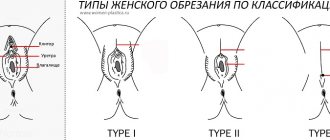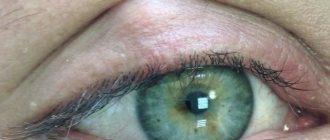Stages of laser circumcision
Laser removal of phimosis is performed under local anesthesia. The procedure for intervention is as follows.
- Anesthesia.
- Applying a tourniquet to the base of the penis.
- Disinfection of the organ.
- A laser scalpel is used to make a shallow circular incision along the outside of the foreskin.
- A circular skin incision is made under the crown of the head.
- The foreskin is removed.
- Skin areas are sutured; absorbable threads are used for sutures.
Stopping blood during a laser cut is not carried out, since the light beam seals the vessels, bleeding is minimal.
Circumcision methods
Depending on the indications, requirements of the patient, as well as the characteristics of his physiology, different methods of circumcision are used. Experts distinguish the following types of surgical interventions:
- minimal excision;
- partial removal;
- free circumcision;
- moderate circumcision;
- tight.
Minimal removal
It is performed for medical reasons. The method is used to remove a scar ring that prevents exposure of the head if the patient does not want to get rid of the prepuce. The appearance of the organ changes little, since a small amount of skin is excised.
Partial
This method is also used due to medical necessity. It does not change the appearance of the penis much - not the entire foreskin is cut off, but its narrowest part. Only the upper part of the head with the opening of the urethra remains open. This is the optimal type of operation if the patient is indicated for treatment, but does not want to undergo classic circumcision.
Free
Otherwise it is called non-tight. A relatively large area of skin is removed. As a result, the head of the penis is almost always open. This option is chosen by those who want to improve the aesthetics of the body or get rid of phimosis, but want to maintain sensitivity during sexual intercourse.
Moderate
The second name is middle circumcision. This is the classic option, the most common. After skin removal, the head of the penis is always open, but the skin fold remains. After moderate circumcision, the sensitivity of the organ decreases somewhat and the duration of sexual intercourse increases.
Surgical intervention
The operation can be carried out either traditionally or using new technologies - laser circumcision. Most often, laser circumcision is performed on children and adult men. Where is laser circumcision performed? This is a simple operation, but the procedure should be performed only by experienced surgeons and only in a hospital setting, for example, in Moscow - this is the Medicine and Beauty on Paveletskaya clinic, located at 6th Monetchikovsky Lane, 19.
In St. Petersburg, laser circumcision is performed at the SM-Clinic on Udarnikov Ave., 19 (Ladozhskaya metro station). This is a very important rule, so do not forget that this is, after all, a surgical intervention.
How much does it cost
A pressing question for most patients is how much does circumcision cost? – does not lead clients of the specialized Cheboksary clinic into a state of panic, because “Alan Clinic” has the most loyal prices for services in this sector.
The starting point for laser circumcision will be your contact with a consultant. An appointment with a specialized specialist for an initial examination and clarification of the absence of medical contraindications prohibiting circumcision of the foreskin can be conveniently done online or by phone.
We adhere to a policy of strict confidentiality, and therefore the solution to your “intimate” issue will remain part of your personal life – and our medical confidentiality.
What's better
Today, laser is a safer and more modern way to remove the foreskin - it does not cause bleeding, carefully excises soft tissue, and has a short recovery period. Therefore, it is preferable to choose this method.
The scalpel method is suitable for those who are not willing to pay a large amount for the procedure. Sometimes surgery for medical reasons is performed free of charge in public hospitals.
Before the operation, you will need to pass some tests (for sexually transmitted infections, HIV, blood and urine tests) and undergo a series of examinations to exclude contraindications. You should also consult your doctor and decide together which method of circumcision to use—laser or scalpel. Sometimes it happens that the foreskin can only be removed with a scalpel. Also, together with the doctor, the patient decides how much foreskin can be removed.
Circumcision should be performed by an experienced surgeon . The inexperience of the doctor can lead to serious complications. It is best to pay money and have the operation done in a specialized clinic. It is worth considering that the clinic must have a license.
Medicine and healthComment
Indications and contraindications for circumcision
The operation is prescribed in the following situations:
- balanitis and balanoposthitis, complicated by phimosis (narrowing of the foreskin), when other treatment methods have not brought the desired result;
- difficulty urinating caused by chronic inflammation;
- solving problems of erectile dysfunction (as one of the treatment methods for premature ejaculation).
Circumcision is also performed at the request of the patient: for aesthetic and religious reasons.
Laser circumcision of the foreskin is not performed for balanoposthitis and other inflammatory diseases of the penis in the acute stage. The operation is postponed until the patient's condition stabilizes.
Laser circumcision
The essence of the laser circumcision operation, as well as its stages, preoperative preparation and postoperative care do not differ from those with other circumcision methods. Laser circumcision differs from traditional circumcision in that instead of scissors or a scalpel, a laser beam is used to remove the foreskin. It is believed that this method allows for greater precision in removing the skin and mucous membrane of the prepuce. Laser circumcision is the treatment of choice for children and can also be used in adults. In some countries, this technique is the “gold standard”, and many patients regard laser technology as a panacea for all diseases. According to a number of studies, laser circumcision is a more reliable and safe method. However, many surgeons do not see much benefit.
How does a laser work?
The use of a laser is associated with two of its effects - mechanical and thermal. For surgeons, including urologists, the most important is the thermal effect of laser radiation. The thermal effect is that light energy is absorbed by tissues and converted into heat, which leads to the destruction of protein structures of cells at 42-65ᵒC, coagulation of blood vessels at 70ᵒC, complete “drying” of cells at 100ᵒC, and at 300ᵒC vaporization occurs (complete evaporation fabrics). Thus, the operation is based on the use of the thermal effect of a laser beam to remove the foreskin. Laser energy is absorbed by tissues and vaporization occurs to a depth of no more than one millimeter, which makes it possible to cut off and remove excess prepuce.
Laser circumcision has a number of advantages compared to traditional circumcision:
- Bleeding control. Unlike the use of conventional surgical scissors or a scalpel, the laser not only dissects tissue, but also due to the high temperature, instantaneous coagulation of the wound edge and blood vessels occurs, which reduces bleeding to almost zero. Preferably in patients with an increased tendency to bleeding , for example, hemophiliacs.
- The use of a laser does not cause significant pain during the procedure, so the operation can be performed under local or regional anesthesia.
- Associated with a lower risk of developing local infection after surgery.
- The postoperative period is accompanied by less pronounced discomfort and minor pain.
- The recovery and healing period is faster than with traditional circumcision.
- Due to more precise removal of the intended volume of prepuce, an excellent cosmetic effect is achieved.
- The operation lasts no more than twenty minutes, while traditional circumcision can take up to forty minutes.
Circumcision in medicine
Qualified medical specialists have many years of experience in successfully performing operations in the field of intimate plastic surgery. Circumcision performed in a hospital setting under local anesthesia for patients over 18 years of age guarantees:
- absence of traumatic tissue dissection, and therefore bleeding;
- local excision of the prepuce, without affecting adjacent areas of the flesh;
- leveling the possibility of developing complications, inflammatory processes and infections;
- accelerated course of rehabilitation (within 10 days);
- no need to remove sutures;
- aesthetic perfection of the genital organ after completion of restoration measures (no stitches or scars;
- information support and advice at all stages of cooperation.
Benefits of laser circumcision
Laser circumcision of a boy's prepuce takes about 20 minutes. The operation usually does not require hospitalization. The laser beam, whose temperature reaches 300 degrees Celsius, acts precisely, so tissue damage is minimized. The laser not only vaporizes the foreskin tissue, but also seals the vessels, thereby minimizing the risk of severe bleeding.
Immediately after the procedure, a crust forms over the wound, which performs a protective function, prevents infection and accelerates tissue restoration. Parents should ensure that the boy does not scratch or tear off this scab. After 1-2 weeks, a new epidermis will form under it and it will fall off on its own. With strict adherence to the specialist’s recommendations, the risks of wound infection in the postoperative period are minimized, and it heals without the formation of a noticeable scar or rough scar.
Disadvantages and possible complications
Full recovery occurs within 2-3 weeks. It is during this period that complications most often arise due to failure to follow the doctor’s recommendations. The patient must exclude sexual intercourse, masturbation and the very fact of arousal, as well as heavy physical activity and mating (tight underwear, sauna, bathhouse, hot bath).
Otherwise, undesirable consequences may occur. Laser circumcision has the following negative aspects:
- during the rehabilitation period, a person will still experience discomfort, discomfort or pain;
- the risk of bleeding and infection still remains;
- the human factor cannot be excluded (errors on the part of the doctor, medical personnel);
- It often becomes more difficult for men to achieve orgasm.
Among the rarest complications is erectile dysfunction (partial or complete). Therefore, it makes sense to strictly adhere to all medical instructions, and in case of problems, immediately seek help.
The operation cannot be performed in case of acute inflammation of the genitourinary organs, as well as fever of infectious origin (viral and bacterial diseases). If there are neoplasms in the area of the glans or foreskin, the issue is decided solely by the doctor; in other cases, the choice is yours.
Preparation
Preparing for laser circumcision is not very difficult.
The operation requires passing a health test. Before the procedure, you should take tests and undergo examinations:
- Donate blood for clinical and biochemical tests.
- Donate urine.
- Make a coagulogram.
- Tests for hepatitis B and C, syphilis, HIV.
- If you are over 50, then an additional consultation with a specialist and additional simple tests are prescribed.
Shortly before the operation, the patient must remove pubic hair and take a shower.
Preparing for surgery
Regardless of whether laser treatment of phimosis, circumcision after converting to Islam or Judaism, or removal of the prepuce for aesthetic or other reasons is performed, the patient is carefully examined before the procedure. This is necessary to identify contraindications to surgery and to study the general state of health.
Preliminary diagnosis helps the specialist create the optimal tactics for managing the patient before, during and after surgery.
As part of the examination, the doctor prescribes tests (general urine and blood tests, biochemistry, smears), and the patient is given a cardiogram. A man needs a consultation with a therapist and anesthesiologist to choose the most appropriate type of anesthesia: local anesthesia or general anesthesia. If the patient has the examination results in hand, the intervention can be performed on the day of treatment. This is especially true for advanced phimosis.
The examination also examines the anatomical features of the penis. This is needed to determine how much skin to remove. If this is not done, there is a high risk of severe tension on the skin after circumcision, which will lead to deformation of the penis. In addition, pain during sexual intercourse and other problems may occur.
Indications for excision of the foreskin
From a medical point of view, circumcision is a necessary measure when diagnosing:
- balanitis;
- phimosis;
- paraphimosis;
- urinary dysfunction caused by inflammation in the area of the head of the penis;
- traumatic deformation of the foreskin;
- premature ejaculation associated with hypersensitivity of the head;
- Keir's erythroplasia, etc.
Circumcision relieves a man of the risk of mechanical damage to the foreskin during erection and eliminates the possibility of rupture of the short frenulum of the penis due to the anatomical features of its structure.
As a result of the absence of microtraumas and a natural “pocket” for the proliferation of bacteria, the risk of developing sexually transmitted and infectious diseases of the genitourinary system that have a contact spread nature is significantly reduced.
Based on the totality of aesthetic “advantages”, the decision - to do or not to circumcise the foreskin - in most cases remains with the patient. An exception is the medical necessity of circumcision - in particular, with congenital and acquired pathology of the foreskin and the development of phimosis, which is possible at any age.
Advantages and disadvantages
Laser circumcision of the foreskin has certain advantages and disadvantages. Let's list the advantages:
- Reduction of inflammatory processes.
- Easy maintenance of intimate hygiene.
- It is a preventive procedure for cases of increased risk of cancer.
- Aesthetic appeal.
- A fairly inexpensive procedure.
The main disadvantages of circumcision:
- Dryness may occur due to decreased natural moisture.
- Increased risk of injury.
- Change in sensitivity.
- There may be discomfort after the procedure.
That is why, before the procedure, a preliminary consultation with a urologist is necessary in order to understand all the pros and cons of circumcision.










